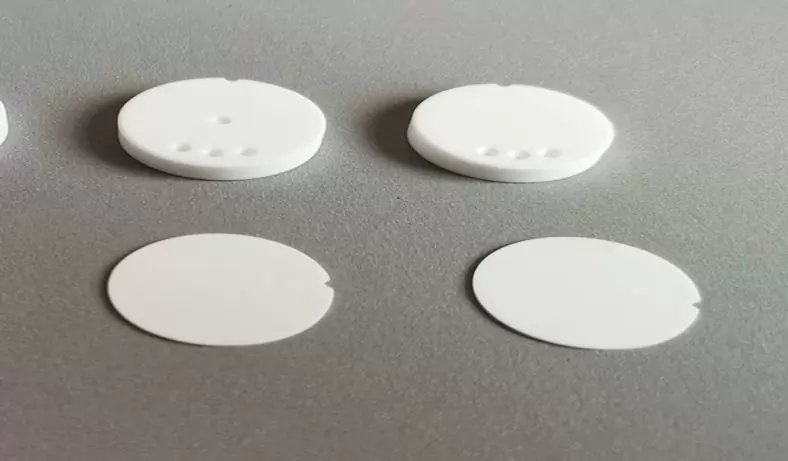α-Al2O3 ceramic materials have the advantages of high strength, superior insulation and chemical stability, good dielectric properties, etc., and are widely used in electronics, machinery, chemical industry, aerospace and other fields.

In recent years, with the rapid development of microelectronics technology, especially hybrid integrated circuit (HIC) and multi-chip module (MCM) technology, the wide application of alumina ceramic suction sheets has attracted more and more attention.
Among various molding processes, the organic tape casting method to prepare alumina substrates has the advantages of low cost, high efficiency, uniform film properties and easy control, and has become the preferred method for preparing high-performance alumina ceramic suction sheets.
What Is The aluminum Oxide Ceramic Suction Sheet From Pintejin Ceramics?
The non-aqueous-based tape casting process refers to the use of benzene, alcohols, ketones and other organic substances as organic solvents for inorganic powders, and the first stage of ball milling is carried out, and then additives such as binders, plasticizers, and dispersants are added for the second stage. Segment ball milling to obtain a slurry suitable for tape casting, and the green substrate is obtained by tape casting on a casting machine. The non-water-based tape casting process is used in large-scale industrial production due to its following advantages:
- The process is simple, and the equipment requirements are not high;
- The cost is relatively low;
- The product has stable performance and is easy to be mass-produced.
In view of the pollution of organic solvents to the production environment, some people are now trying to replace organic casting with water-based casting, but because of the harsh requirements on water-based casting processes and equipment, as well as poor product performance stability, it has been stuck in the laboratory stage. . In this study, the influence of the mixed solvent ratio, the amount of additives and the firing system on the performance of the substrate in the non-aqueous casting process was discussed.
1.Raw Materials
Using high-purity ultra-fine alumina powder, the average particle size measured by JL-1155 laser particle size distribution analyzer is 1.21μm, the sintering aid is ultra-fine talc powder, the mixed solvent is toluene and n-butanol, and the binder is polyethylene. Butyral (PVB), polyethylene glycol-400 (PEG-400) as plasticizer, and fish oil as dispersant, all of which are of analytical grade.
2.Slurry Preparation And Viscosity Test
The laboratory uses a two-stage ball milling method to prepare the casting slurry. In the first stage, a certain amount of alumina powder, an appropriate amount of ultra-fine talc powder and a ball milling medium are added to the ball milling tank, and then an appropriate amount of toluene and n-butanol solvent are measured. Ball milling, in order to obtain good dispersibility, add a small amount of fish oil, and ball mill for 7-8 hours; in the second stage, add plasticizer (PEG-400) binder (PVB), and continue ball milling for 6-7 hours to obtain slurry. 250 mesh sieve, vacuum defoaming, slurry viscosity was measured with NDJ-1 rotational viscometer.
3.Sample Preparation And Performance Testing
Cast the prepared slurry suitable for casting on the LY-250-1 type casting machine, the speed of the casting belt is 0.5~0.7m/min, and the four-stage drying is adopted. By adjusting the height of the casting scraper blade and the casting belt The speed controls the thickness of the cast sheet. Cut the dried green body into a certain size and put it into the electric furnace for sintering under the established firing system. JSM-6700F field emission scanning electron microscope was used for analysis, ZC36 high resistance meter was used to test the resistance R and the volume resistivity Pv was calculated. Use HP4294A measuring instrument to measure capacitance C and dielectric loss tgδ (measurement frequency is IMHz) and calculate dielectric constant ε.
- The optimum ratio of alumina non-aqueous casting additives is: composite solvent 27.5wt% (toluene: n-butanol is 5:3), binder 5wt%, plasticizer 2wt%, dispersant 0.6 wt%, a slurry with a viscosity of 2100-3500 mPa·s can be obtained, and the slurry has good fluidity.
- Using the slurry prepared by the above formula process, the green alumina ceramic suction sheet is prepared by tape casting, and the porosity of the ceramic side comb reaches a minimum of 1% and a maximum bulk density of 3.780g/cm3 when sintered at 1575 °C. . The microstructure of the sintered alumina ceramic suction sheet is fine, uniform, dense, and has excellent dielectric properties. Pintejin Ceramics specializes in machining this type of alumina ceramic material and has rich experience. There is a certain quality assurance.
